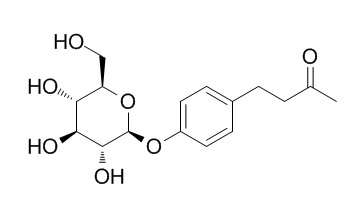Raspberryketone glucoside
Raspberry ketone glucoside has lasting effects for the inhibition of melanogenesis and various melanogenic factors after the degradation in the skin.
Inquire / Order:
manager@chemfaces.com
Technical Inquiries:
service@chemfaces.com
Tel:
+86-27-84237783
Fax:
+86-27-84254680
Address:
1 Building, No. 83, CheCheng Rd., Wuhan Economic and Technological Development Zone, Wuhan, Hubei 430056, PRC
Providing storage is as stated on the product vial and the vial is kept tightly sealed, the product can be stored for up to
24 months(2-8C).
Wherever possible, you should prepare and use solutions on the same day. However, if you need to make up stock solutions in advance, we recommend that you store the solution as aliquots in tightly sealed vials at -20C. Generally, these will be useable for up to two weeks. Before use, and prior to opening the vial we recommend that you allow your product to equilibrate to room temperature for at least 1 hour.
Need more advice on solubility, usage and handling? Please email to: service@chemfaces.com
The packaging of the product may have turned upside down during transportation, resulting in the natural compounds adhering to the neck or cap of the vial. take the vial out of its packaging and gently shake to let the compounds fall to the bottom of the vial. for liquid products, centrifuge at 200-500 RPM to gather the liquid at the bottom of the vial. try to avoid loss or contamination during handling.
Phytomedicine.2018, 41:62-66
Cosmetics2025, 12(3), 108
Planta Med.2022, 88(9-10):794-804.
Metabolites.2019, 9(11):E271
Aquaculture2017, 481:94-102
Bioorg Med Chem.2018, 26(14):4201-4208
ACS Omega.2021, 6(36):23460-23474.
Nutr Cancer.2023, 75(1):376-387.
Nutrients.2021, 13(10):3414.
Horticulture Research2023, uhad164.
Related and Featured Products
Journal of Society of Cosmetic Chemists of Japan, 2001, 35(2):120-126.
Lasting Effect of Raspberry Ketone Glucoside on Whitening.[Reference:
WebLink]
Tyrosinase is well-known as a key enzyme responsible for the production of melanin in melanocytes. It is also known that inflammatory reactions such as active oxygen species and melanogenic factors in the skin are induced by UV irradiation.
METHODS AND RESULTS:
The keys to suppress melanin synthesis are considered to be not only the inhibition of tyrosinase activity but also that of inflammatory reactions. Raspberryketone glucoside (RKG) in raspberry fruit (Rubus ideaeus) had the inhibitory effect on the melanin synthesis. As a result of an investigation with the glycosides that have similar structure of RKG at its glycoside moieties and alkyl chain, the structure of RKG was found to be suitable as an inhibitory factor on melanogenesis. RKG released raspberry ketone (RK) gradually after the reaction with both homogenated and desquamated cells of the stratum corneum. In addition to the inhibitory effect of melanin synthesis, RK also showed remarkable functions such as the scavenge of nitric oxide (NO) which was considered to induce pigmentation of human skin through activation of melanogenesis and the inhibition of the inflammation-related reactions such as production of superoxide anion and lipid peroxide.
CONCLUSIONS:
These data indicated that RKG had lasting effects for the inhibition of melanogenesis and various melanogenic factors after the degradation in the skin.



